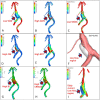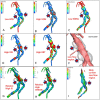Wall enhancement predictive of abnormal hemodynamics and ischemia in vertebrobasilar non-saccular aneurysms: a pilot study
- PMID: 37333010
- PMCID: PMC10272805
- DOI: 10.3389/fneur.2023.1108904
Wall enhancement predictive of abnormal hemodynamics and ischemia in vertebrobasilar non-saccular aneurysms: a pilot study
Abstract
Objective: To analyze how wall enhancement affects hemodynamics and cerebral ischemic risk factors in vertebrobasilar non-saccular intracranial aneurysms (VBNIAs).
Materials and methods: Ten consecutive non-saccular aneurysms were collected, including three transitional vertebrobasilar dolichoectasia (TVBD). A wall enhancement model was quantitatively constructed to analyze how wall enhancement interacts with hemodynamics and cerebral ischemic factors.
Results: Enhanced area revealed low wall shear stress (WSS) and wall shear stress gradient (WSSG), with high oscillatory shear index (OSI), relative residence time (RRT), and gradient oscillatory number (GON) while the vortex and slow flow region in fusiform aneurysms are similar to TVBD fusiform aneurysms. With low OSI, high RRT and similar GON in the dilated segment, the enhanced area still manifests low WSS and WSSG in the slow flow area with no vortex. In fusiform aneurysms, wall enhancement was negatively correlated with WSS (except for case 71, all p values < 0.05, r = -0.52 ~ -0.95), while wall enhancement was positively correlated with OSI (except for case 5, all p values < 0.05, r = 0.50 ~ 0.83). For the 10 fusiform aneurysms, wall enhancement is significantly positively correlated with OSI (p = 0.0002, r = 0.75) and slightly negatively correlated with WSS (p = 0.196, r = -0.30) throughout the dataset. Aneurysm length, width, low wall shear stress area (LSA), high OSI, low flow volume (LFV), RRT, and high aneurysm-to-pituitary stalk contrast ratio (CRstalk) area plus proportion may be predictive of cerebral ischemia.
Conclusion: A wall enhancement quantitative model was established for vertebrobasilar non-saccular aneurysms. Low WSS was negatively correlated with wall enhancement, while high OSI was positively correlated with wall enhancement. Fusiform aneurysm hemodynamics in TVBD are similar to simple fusiform aneurysms. Cerebral ischemia risk appears to be correlated with large size, high OSI, LSA, and RRT, LFV, and wall enhancement.
Keywords: computed fluid dynamics; high-resolution MRI; oscillatory shear index; vertebrobasilar fusiform aneurysm; wall enhancement.
Copyright © 2023 Jiang, Ge, Lu, Wan, Chen, Zou, Leng, Xiang and Zhang.
Conflict of interest statement
QC, RZ, XL, and JX were employed by ArteryFlow Technology Co., Ltd. The remaining authors declare that the research was conducted in the absence of any commercial or financial relationships that could be construed as a potential conflict of interest.
Figures




Similar articles
-
Aneurysm wall enhancement, hemodynamics, and morphology of intracranial fusiform aneurysms.Front Aging Neurosci. 2023 Mar 13;15:1145542. doi: 10.3389/fnagi.2023.1145542. eCollection 2023. Front Aging Neurosci. 2023. PMID: 36993906 Free PMC article.
-
Wall shear stress and relative residence time as potential risk factors for abdominal aortic aneurysms in males: a 4D flow cardiovascular magnetic resonance case-control study.J Cardiovasc Magn Reson. 2022 Mar 18;24(1):18. doi: 10.1186/s12968-022-00848-2. J Cardiovasc Magn Reson. 2022. PMID: 35303893 Free PMC article.
-
Standardized viscosity as a source of error in computational fluid dynamic simulations of cerebral aneurysms.Med Phys. 2024 Feb;51(2):1499-1508. doi: 10.1002/mp.16926. Epub 2023 Dec 27. Med Phys. 2024. PMID: 38150511 Free PMC article.
-
How does hemodynamics affect rupture tissue mechanics in abdominal aortic aneurysm: Focus on wall shear stress derived parameters, time-averaged wall shear stress, oscillatory shear index, endothelial cell activation potential, and relative residence time.Comput Biol Med. 2023 Mar;154:106609. doi: 10.1016/j.compbiomed.2023.106609. Epub 2023 Jan 23. Comput Biol Med. 2023. PMID: 36724610 Review.
-
Hemodynamics in a Middle Cerebral Artery Aneurysm Before Its Growth and Fatal Rupture: Case Study and Review of the Literature.World Neurosurg. 2018 Nov;119:e395-e402. doi: 10.1016/j.wneu.2018.07.174. Epub 2018 Jul 30. World Neurosurg. 2018. PMID: 30071328 Review.
Cited by
-
Analysis of perfusion in patients with vertebrobasilar dolichoectasia through use of multidelay arterial spin labeling magnetic resonance imaging.Quant Imaging Med Surg. 2025 Aug 1;15(8):7246-7258. doi: 10.21037/qims-24-2031. Epub 2025 Jul 28. Quant Imaging Med Surg. 2025. PMID: 40785856 Free PMC article.
References
LinkOut - more resources
Full Text Sources
Research Materials

